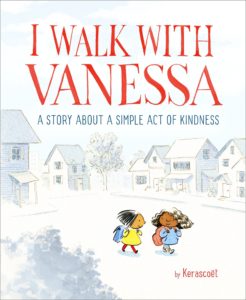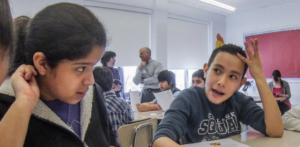Why I Picked It Up:
Sherry and I were preparing for a Newer Choices in Children’s Literacy and I found this gem! So, I am guessing it was either recommended on a Google search or on one of the many blogs I follow.
Why I Finished It:
I love this story so much. It is a simple, wordless picture book that packs a big punch! While it clearly targets a younger audience, the message could be discussed with an audience of any age (even adults!). Bullying is a hot topic at the moment, and I think many times adults don’t know how to address it and kids don’t know what to do. In this beautiful story, a brave little girl couldn’t stop thinking about a new student who was being verbally attacked by another student. She thought throughout the night about how to help the situation and she came up with a brilliant plan.
Who I Would Give It To:
I think all students can relate to this story in some way. Students might connect to being new to a school or group, or they might connect with someone new coming into their school. Either way, it provides students with different perspectives and ideas about how to be inclusive and help new people adjust. I think teachers should really consider using this book in their class, possibly the first week of school or before a new student arrives. Many times I hear adults tell kids to stand up to the bully, but I’m not really sure that’s always the best scenario. This book sheds light on a way every kid can help and in the backmatter, it offers more ideas and helpful vocabulary.
Integration Idea:
Theme and Social Skills
While there are so many fun topics to discuss with this story, bullying is definitely front and center. This text could be used as a springboard to discuss this topic and how it relates to them. Choose an essential question to begin students talking.
- How are people affected by other people?
- Why do people respond differently to similar situations?
- How do we know if someone is being bullied? What do we do if we are being bullied or know of someone being bullied?
As you open up conversations about bullying with the students, be open and raw. It’s important to really remember and think about what it’s like to be young and the pressures our students face daily. We do students a disservice when we provide an “after-school special” stance on how they should feel and react. Reach out to school counselors and others who might be able to help. Also check out this website: https://www.stopbullying.gov/ .
Retelling (Reading) and Generating Ideas and Drafting (writing)
After “reading” this picture book one time through, have students discuss what connections they have to the story. I like to have the students share with someone sitting next to them or in groups of three. Come together as a class to share different connections and then let students write down their personal story ideas in their Writers’ Notebook. Then have the students work on retelling the story. To retell, have an anchor chart ready that is divided into three rows labeled; beginning, middle, and end. Ask students what happened in the beginning. I like to let quite a bit of discussion between the students happen here. If I let one student respond by raising their hand, everyone has an invitation to shut off. So, we all discuss and then agree, as a class, what happened in the beginning. I repeat this for the middle and the end. Once we have written down our retell on the chart paper, we reread it together as a class.
Since we just talked about how the story was told in order, I have students choose one of the ideas that they generated earlier and practice telling a partner their own story, following the same pattern of beginning, middle, and end. During this time, you can have students just listen to each other or you can have the listening partner ask questions for clarifications to get the first student to elaborate on their story. Once students have shared their stories a few times in order, they’re ready to begin drafting!
Character Analysis (Making Inferences)
This entire story relies on the reader to analyze the character’s actions through drawings alone. This is the perfect way to get students started on making inferences about characters. Choose Vanessa or the sweet girl who chose to make a difference and follow them through the book. On each page, ask the students what the character is doing. What are her actions and/or reactions? Ask students how they think she is feeling based on these actions and what personality traits she possesses. In the end, ask students if they were static or changed throughout the story. Remind students that feelings change, but traits tend to be more constant.
Try our character feeling/traits cards.
How have you used this picture book?










Leave a Reply